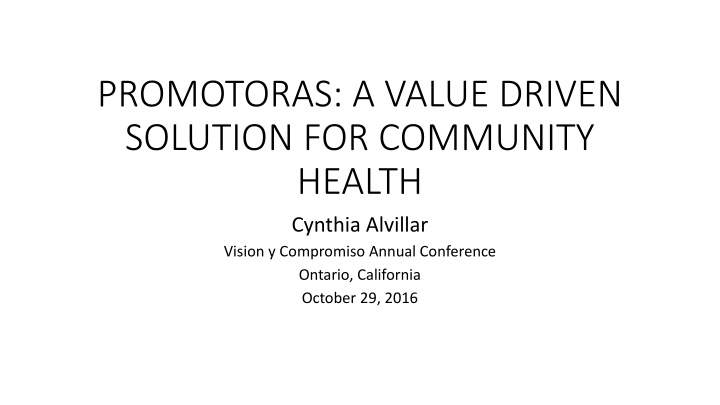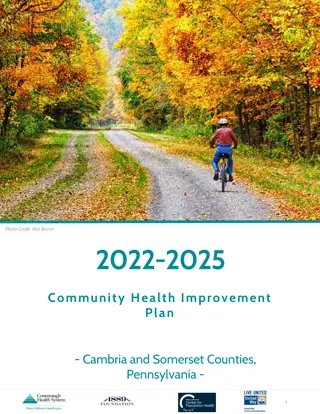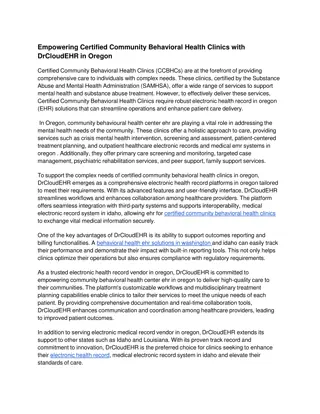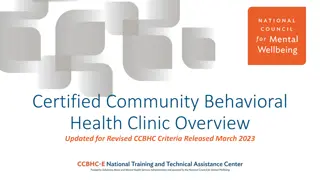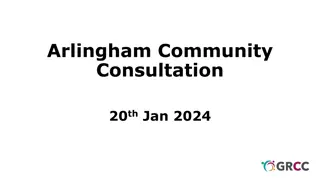Value-Driven Community Health Solutions
The importance of measuring ROI in community health programs, focusing on cost savings, sustainability goals, and outcomes. Challenges in documenting CHW activities and the need for common metrics. Discussing alternatives to quantitative measures for assessing program effectiveness."
Download Presentation

Please find below an Image/Link to download the presentation.
The content on the website is provided AS IS for your information and personal use only. It may not be sold, licensed, or shared on other websites without obtaining consent from the author.If you encounter any issues during the download, it is possible that the publisher has removed the file from their server.
You are allowed to download the files provided on this website for personal or commercial use, subject to the condition that they are used lawfully. All files are the property of their respective owners.
The content on the website is provided AS IS for your information and personal use only. It may not be sold, licensed, or shared on other websites without obtaining consent from the author.
E N D
Presentation Transcript
PROMOTORAS: A VALUE DRIVEN SOLUTION FOR COMMUNITY HEALTH Cynthia Alvillar Vision y Compromiso Annual Conference Ontario, California October 29, 2016
Why ROI? Why are we looking at ROI? What is the impetus for measuring ROI? Until now there has not been massive research on ROI, yet there have been important pro-CHW decisions without it Some wish to measure and manage their core health-related value/sustainability goals. Some argue that in some cases demonstrating improved health outcomes alone is not sufficient in order to sustain programs. Some have found that a positive ROI is also necessary to continue when grant funding comes to an end.
Why ROI? The Center for Medicare and Medicaid Innovation Models, which encourages the use of CHWs, requires its grant recipients to show cost savings and analysis of returns on investment.
Why ROI? Triple Aim Improving patient experience and care (quality and satisfaction) Improving the health of populations Reducing the per capita cost of health care
What is your experience Are you feeling compelled to measure ROI? Is it something you feel comfortable doing? Are you eager to show the cost savings?
Standards, Metrics, and Documentation Documentation of CHW activity has not been a high priority Historically separate from medical records Lack of common metrics has hampered pooling and comparison of data No coherent research strategy exists Example: Center for Medicare and Medicaid Innovation (CMMI) Grants Increasing recognition of beneficial CHW roles in research Value of CHW observations for clinicians is being recognized Adapting to the CHW workforce: Equipping CHW s to document and report appropriately User-friendly documentation tools for field work
Standards, Metrics, and Documentation or Is ROI the only or best measure? There is a difference between activity and volume based billing and a outcome and value based system. The latter is more conducive to the sustainability of the CHW role because improving outcomes are seen as cost reduction. Are there alternatives to a quantitative measure (cultures of health, improved outcomes, healthier communities)? Carl Rush points out that As long as hospitals are paid for units of service (days of inpatient stay and procedures performed) hospitals are not interested in ROI in terms of CHWs reducing avoidable hospitalizations except for uncompensated care. The is it cost-effective question reflects a limited understanding of CHW roles and capabilities by those that think of personnel as either clinical or administrative. CHW are neither.
What is ROI? It is a ratio of savings or net revenue improvement as a result of a program divided by the program costs. It is a purely financial measure The larger the ROI, the more financially desirable the intervention. The results you get allow you to compare programs
Defining the Return on Investment Benefits/cost ratio = Monetary benefits/Program costs ROI (%) = Net Monetary Benefits* X 100 Program Costs Example: costs for project $80,000 Benefits from program (1styear) $240,000 BCR=________ *net means benefits cost; for ROI divide by costs ROI= ---------------------------- X 100 = ______%
ROI Best Practices A variety of data collection methods are used in ROI analysis For a specific ROI evaluation, the effects of the solution are isolated from other influences Impact data are converted into monetary values to show benefits or savings Savings calculations should reflect all utilization and cost of health care services, including savings from reduced utilization (emergency room visits, hospitalizations, etc.) offset for increased utilization of other services, such as primary care Time frame matters because the cost savings are often in the long run
ROI requires more intricate data Data collection on process measures Clients seen Applications taken Referrals given An example of the data collected in Denver: Type of contacts Enrollments Educational presentations and events Community partners Client demographics Number and types of services and referrals provided Data on these measures do not tell the whole story
ROI is not always straightforward Calculating ROI is difficult for several reasons: For example: What portion of successes can be attributed to the CHWs work? What outcome or performance measures should be used to fairly assess their work and value? Who is responsible and accountable for each patient? Especially in a team setting? How do we measure prevention and quantify the dollars saved by CHWs? Different ways to find savings (numerator) Must avoid double counting
Existing studies Some research also shows positive effects of CHWs on patients health in some contexts and for certain diseases, such as hypertension or diabetes. While there are a handful of published studies, the true effect of CHWs on patient care and health care costs is still difficult to determine, in large part due to limitations of the research. For example, one review found some evidence that CHWs can positively influence patient behavior and health, but the evidence was insufficient to evaluate cost effectiveness. Very few studies have examined cost or cost effectiveness.
Existing studies Programs across the country have tried to study their effectiveness. Arkansas CHW program saw a nearly three-to-one return on investment of Medicaid expenditures for a program that worked with Medicaid enrollees with unmet long-term care needs, and helped beneficiaries access appropriate home and community-based services rather than costly nursing homes. Baltimore, MD CHW program showed that African-American Medicaid patients with diabetes had significant decreases in ED visits by 40%, in ED admissions by 33%, in total hospital admissions by 33% and Medicaid expenditures that decreased by 27%. Savings were $2245 per patient or $262,080 for all involved patients.
The Denver Study Looked at the ROI of outreach by CHWs to underserved men Examined service utilization, charges and reimbursements Denver has an integrated info system includes Clinical Financial Practice management system Insurance enrollment management system Case management Managed care Medical record number track patients through primary, specialty, emergency care and hospitalization
The Denver Study In Colorado, a Denver Health program employed CHWs to reach out to men in underserved communities to increase access to health care. Denver s program found that it saved on the cost of health care services with a return on investment of more than $2 for every $1 spent on the program. Pre-/post method applied Pre-intervention baseline data was compiled Post-intervention follow-up measures were captured Pre- and post-intervention visits classified as primary care, urgent care, outpatient behavior health, medical specialty care, dental or inpatient.
Denver Study The total difference in charges and reimbursements was compared between pre- and post-intervention to establish the average monthly financial impact of the program. Costs: CHW salaries and benefits Miscellaneous program costs Employee mileage reimbursement Bus token for cliens Visit co-pays Medical supplies
Denver Study Change in utilization found Primary care and specialty visits increased Urgent care, behavioral and inpatient visits decreased Savings: uncompensated charges fell causing a savings of $14,224/mo Costs (salary and other program costs) $6229/mo ROI= 14,224/6229=2.28 ROI is monthly savings divided by monthly costs
The Sub-Saharan Study Looked at the annual ROI for adding 734,000 CHWs Costs: cost of employing CHWs Benefits: Productivity from lives saved (economic value of lives saved=number of lives saved X expected future economic output of lives saved) Avoiding or limiting health crises Increased economic activity from employment of CHWs Results showed a 10:1 return on investment
What we have learned from existing studies A growing body of research demonstrates that CHWs improve health outcomes, especially among vulnerable, low-income populations. This finding is especially true when CHWs are incorporated into disease prevention programs and chronic disease management, for diseases like diabetes, asthma, hypertension, and depression. http://www.dph.illinois.gov/sites/default/files/publications/do-chw- report-1-19-16.pdf
What we have learned from existing studies the variety of roles, settings and populations in which CHWs serve create challenges for rigorous evaluation. diversity of contexts means that some findings may not be applicable in other health system settings. more research is needed to determine the effectiveness of community health workers.
What about your programs? How do funders currently ask you to capture deliverables? Is there a request to capture value of services rendered? How do they currently ask you to capture the impact of the services rendered? How do you currently do that?
Lets do an ROI exercise Let s look at a program or an intervention for promotoras The goal is to figure out how much it costs and how much we saved because of the intervention.
Things to consider: benefits What does the promotora do? What would it cost to achieve these things without a promotora? Is it even possible to do so? Or is there qualitative value that is created, and can it be measured?
Things to consider: cost reduction How do CHWs reduce cost? Improve access, reduce ER use, improve chronic care?
Things to consider: how to measure How to measure the impact CHWs can have on improving the lives of the communities they serve (for example, how do we measure better health outcomes) How do we show that CHWs improve the health and wellness of (vulnerable) communities and save health care costs?
Defining the Return on Investment Benefits/cost ratio = Monetary benefits/Program costs ROI (%) = Net Monetary Benefits X 100 Program Costs Example: costs fro project $80,000 Benefits from program (1styear) $240,000 BCR=________ ROI= ---------------------------- X 100 = ______%
So where should we start? Let s look at roles
Roles 1. Community Engagement and Advocacy a. Recruit b. Participate in community assessment of risk and resources c. Participate in environmental and safety assessments d. Participate in community mobilization e. Connecting and engagement f. Community organizing g. Community advocacy h. Engage in leadership 2. System Navigation a. Connect people to health services, insurance, and community resources b. Serve as patient/client advocate: assist patients/clients in advocating for themselves 3. Participatory Research a. Participate in determination of community research agendas b. Critique (from community perspective) proposed research topics and methods c. Identify priority research issues d. Engage stakeholders in research e. Participate in implementation of research f. Participate in research dissemination 4. Public Health Concepts and Approaches/Integration a. Go to where patients/clients are: home, community, clinic, all b. Participate in health promotion c. Participate in community assessment d. Target social/cultural determinants of health e. Conduct cultural mediation among individuals, communities, and systems f. Conduct and support program and service evaluations 5. Coordination of Services a. Provide resources and risk assessment of individuals b. Participate in goal setting, action planning c. Assist clients with basic needs (food, shelter) d. Help clients understand service and care plans e. Facilitate/assist with care plans and services 6. Education a. Promote health literacy: individual and community level b. Provide culturally appropriate, evidence-based health education and information promoting self-management 7. Social-emotional Support a. Conduct behavioral health risk assessment b. Assist with empowerment c. Provide mentoring d. provide supportive counseling and stress management e. provide leadership 8. Community/Cultural liaison a. advocate for clients b. Communicate with others
Roles Comprehensive care management Care coordination Health promotion Transitional care Patient and family support Referral to community and social services
For each team Step One: brainstorm costs for the intervention Think about as many related costs as you can. For example, what will training cost? increased overhead?, etc. Step Two: brainstorm benefits for the intervention Step Three: think of ways to quantify benefits that can help assign a monetary value to the Benefits (be creative) (there are no wrong answers!)
What are your costs? Cost calculations must include all costs: hiring; salaries and benefits training programs: academic and non-academic curricula on core competencies management and admin coordination and integration into public health, health delivery systems, etc. Consider fixed costs: facility buildings and systems, insurance Consider variable costs: travel Costs are relatively easier to estimate than savings
What are the benefits? Benefits must be captured and quantified Start with roles and scope of practice Help navigate the health care system Help with preventative care Manage chronic illnesses Maintain healthy lifestyles Assist people in receiving the care they need in culturally and linguistically relevant ways Promote positive health behaviors and outcomes Help in medically underserved communities Portal to improved women s health outcomes
Conclusion This presentation and workshop was meant to introduce you to the topic Introduce key concepts Highlight some notable studies Next steps If we are going in the direction of measuring ROI Standards can be introduced Key indicators can be identified the methodology can improved over time
